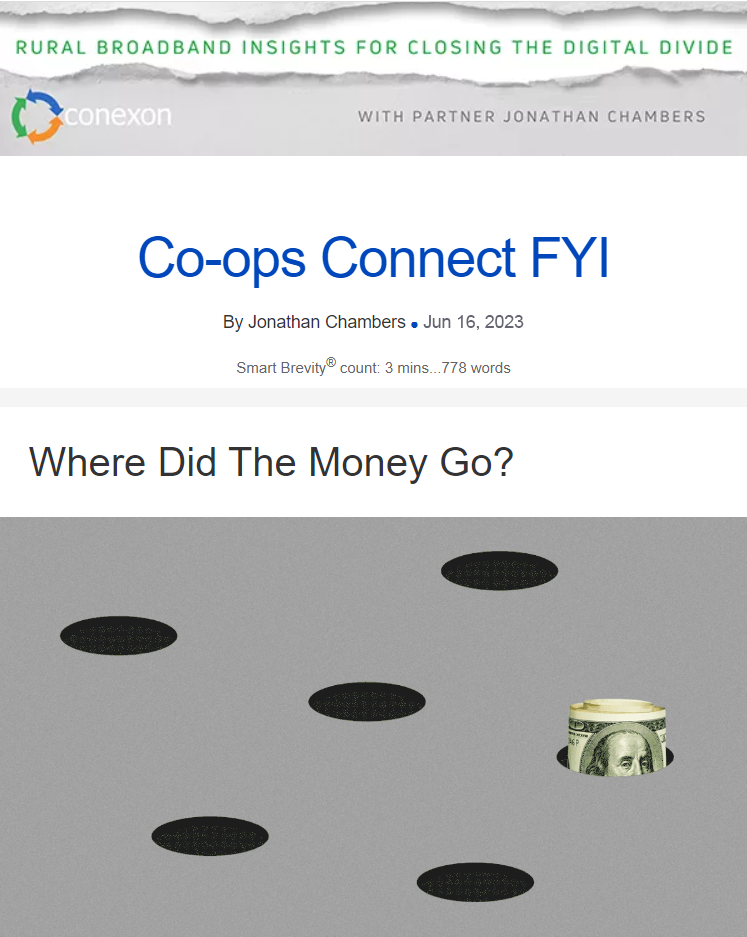Where Did The Money Go?
June 16, 2023
It has been 19 months since passage of the Infrastructure Act.
Within a few weeks, NTIA will announce the BEAD allocations to states.
- Each state will have the opportunity to receive broadband funding and administer a rural broadband program. The allocation will be in approximate proportion to the number of unserved locations in the state compared to the 8.3 million unserved locations in the country.
- Congress could have proscribed a methodology that allocated funding to states in a matter of weeks, not 19 months. Any number of methodologies would have been as accurate as and less time-consuming than the flawed FCC broadband maps.
- Nevertheless, the time for NTIA to act has finally come.
While we wait for NTIA, I thought it useful to remind people how much money has been spent already on rural broadband by the federal government.
By the Numbers
- Until 2011, the FCC programs supported telecommunications (voice services).
But in 2011, the FCC decided to use its authority to collect and spend funds on improving rural broadband services. - The new rural broadband spending began in 2012.
In the decade between 2013 and 2022, the FCC spent - $45.89 billion on its rural, high-cost programs.
- That does not include money spent on rural schools, libraries and health care facilities through the e-rate program and the rural health care program.
Why it matters:
The $42.45 billion BEAD budget for states is enough money to build fiber-optic networks to every rural home in the country.
But (and there’s always a but), not if funding is spent on the same set of companies doing the same thing they’ve done for the past decade.
- In the past decade, more public money was spent by the FCC on rural broadband than the BEAD budget.
- And yet, the nation has approximately the same number of unserved and underserved homes as it did before spending money on rural broadband.
What? How? Why? Because the definition of broadband keeps evolving as homes and businesses use the internet more intensively.
- The FCC programs were long-term (7-10 years), yet the service requirements were not forward-looking.
- The FCC funded service that was outpaced by the internet before the money was spent: First 4/1 Mbps, then 10/1 Mbps, 25/3 Mbps, 100/20 Mbps.
- What should NTIA and the states require in order to be forward- looking? Within a decade, even 1 Gbps speeds will be considered the slow lane.
The bottom line:
Unless BEAD funding is dedicated to long-lived assets — those with at least a 30-year life — we’ll be back where we started in another decade.
Kentucky By The Numbers
Kentucky, FCC High-Cost Programs Total Disbursement, 2003-present
Any state can look up the same information and compare.
For example, the chart above shows the total FCC disbursement amounts in Kentucky over the past 20 years.
Why it matters:
Since the FCC began spending public money on broadband, $1.3 billion has been spent on rural broadband in Kentucky.
- According to the latest FCC maps, Kentucky should be allocated $1.2 billion in BEAD, or close to the same amount that has been spent by the FCC over the past decade.
The bottom line:
Kentucky still has over a half million unserved and underserved locations in the Commonwealth. BEAD must do better.
The Big Picture
It shouldn’t be surprising that the BEAD allocations will mirror the amount spent on rural broadband in each state over the past decade.
- The FCC budget for rural broadband was $45 billion over a 10- year period, nearly identical to BEAD.
- The FCC programs targeted unserved areas of the country.
Can we expect better results with the same amount of money and programs run by states rather than the FCC?
Yes — if state broadband offices avoid the mistakes the FCC made in implementing the Connect America Fund and Rural Digital Opportunity Fund.
The most pertinent questions for a state broadband office to pose to a BEAD applicant:
1. What have you done with public funding to date? (My advice: Avoid recidivism.)
2. What can you build in the next 12 months? In the next 24 months? (My advice: Award funding in annual tranches.)
3. What is the life of the assets being deployed with BEAD funds? (My advice: Invest public money for the long term.)
The bottom line:
The FCC didn’t get those three questions right.
Broadband in rural America now depends on NTIA and the state broadband offices. Don’t let us down.
